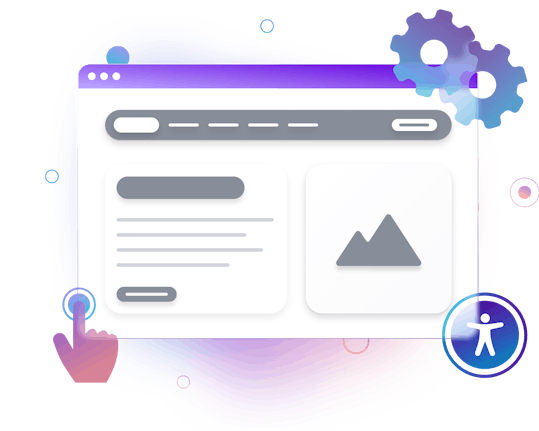ACCESSIBILITY TESTING SERVICE
Web Accessibility Testing and Compliance from AudioEye
Learn how AudioEye’s combination of automated testing and expert human audits can help you find and fix more accessibility issues on your website.

Not All Accessibility Testing Services Are Created Alike
There are several accessibility testing methodologies, from automated testing tools to expert consultants who review each line of code on client websites and mobile applications.
At AudioEye, we use automated accessibility testing and expert human audits to help identify and remediate more of the accessibility violations impacting your visitors:

Active Monitoring
Our Digital Accessibility Platform delivers over 1.3 billion accessibility remediations to customer websites every day — fixing many of the issues identified by ongoing accessibility testing.

Custom Fixes
For issues that cannot be fixed with automation alone, our team of certified accessibility experts write custom, code-based fixes or provide guidance to your internal teams on how to fix them at the source.

Expert Audits
Not every accessibility issue can be identified or resolved by automated accessibility tools, which is why we offer expert testing to uncover additional accessibility violations and usability issues.
What Are the Benefits of Accessibility Testing?
In recent years, the number of accessibility-related lawsuits has skyrocketed — and many accessibility laws point to standards like Web Content Accessibility Guidelines (WCAG) as a means to demonstrate compliance.
However, lowering your risk of legal action isn’t the only reason to look into the accessibility of your digital experiences. Ongoing accessibility testing can also help you:
Reach more customers
Globally, 1 in 6 people live with a disability. Accessibility testing can improve the user experience for these people — driving sales, customer loyalty, and more.
Improve brand reputation
Creating user experiences that are accessible to everyone is a great way to demonstrate your commitment to inclusivity — a key pillar of most inclusion initiatives.
Appear higher in search results
There is plenty of evidence that accessible websites are easier for search engines to crawl — which can lead to higher ranking in search results.
What are the benefits of a combined approach to accessibility testing?
At AudioEye, our combined testing approach uses expert human testing and automated accessibility testing tools to identify and remediate more of the accessibility issues impacting your customers and exposing you to the risk of legal action under laws like the Americans with Disabilities Act (ADA).
Making your websites, mobile apps, and other digital experiences more accessible can support the accessibility needs of a wide range of disabilities, including people with visual impairments, hearing impairments, motor impairments, and cognitive impairments.
How Do Accessibility Audits Work?
At AudioEye, our accessibility testers are real people with disabilities who use assistive technologies — such as JAWS, NVDA, and other screen readers — in their daily lives.
Our Expert Audits provide a comprehensive summary of your website’s most important pages and page templates, supplementing the work done by our ongoing automated accessibility testing:
We prioritize the most-used pages and user flows across your digital content, including content behind login screens or paywalls
Our team of expert testers audit your content using a variety of assistive technologies and browsers for compatibility.
Once your audit is complete, we share a report that includes a breakdown of each test, result, and recommended fix for your developers.
Frequently Asked Questions
- How often should I test the accessibility of my website and other digital channels?
Making accessibility testing a regular part of your software development lifecycle can help you identify and remediate many of the accessibility violations impacting your visitors.
Your accessibility testing team should review your website and other digital content on multiple platforms, including desktop websites and mobile devices.
- What are the limitations of an automation-only approach to accessibility testing?
Unlike automation-only solutions, we pair automated testing and remediation with human experts who can identify accessibility issues that automation alone cannot detect. It’s a more complete approach to digital accessibility — and the only way to be truly compliant.
- What are the limitations of manual testing-only consultants?
Consultants can provide a detailed summary of your site’s accessibility, but they’re slow, expensive, and rarely able to fix issues themselves. Our AI-based automation can remediate many common accessibility issues, freeing our human experts to handle the most complex issues for you.
- Is accessibility testing a legal requirement?
Accessibility testing is not a legal requirement, but accessibility violations — left unchecked — can expose your business to the risk of legal action. In recent years, the number of accessibility-related lawsuits has skyrocketed — and many accessibility laws point to standards like WCAG as a means to demonstrate compliance.
- What can automated accessibility solutions test?
No automated accessibility solution can find or fix every accessibility issue. However, they can test many of the WCAG criteria, the international accessibility standard used by many accessibility laws such as the ADA, AODA, Section 508 of the Rehab Act, and more.
- What accessibility issues can AudioEye test for?
At AudioEye, our automated accessibility testing and expert human audits are focused on the latest Web Content Accessibility Guidlines (WCAG) — which is WCAG 2.2. However, we also test for WCAG 2.1 and WCAG 2.0 criteria, which are included as part of WCAG 2.2.
- What are some common accessibility errors?
Based on data from claims reviewed by AudioEye between July 2021 and July 2022, the accessibility violations cited most often in legal claims are related to missing image alt text descriptions, empty links and buttons, and information and page elements that cannot be accessed by assistive technologies.
- Who performs accessibility testing?
Accessibility testing can include both manual and automated testing of websites and other digital content, conducted by certified accessibility experts and members of the disability community. Testers will typically use automated site scans, code reviews, and assistive technology (AT) to identify accessibility violations.